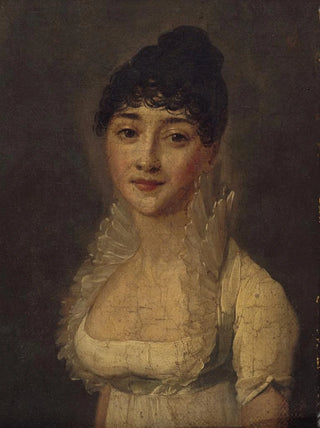Art print | Portrait of a woman in a white dress - Louis Léopold Boilly


View from behind

Frame (optional)
In the fascinating world of 19th-century painting, the "Art print of a woman in a white dress" by Louis Léopold Boilly stands out for its delicacy and elegance. This piece, both intimate and evocative, transports us to a realm where beauty and sophistication intertwine. Boilly, master of the portrait, succeeds in capturing not only the physical appearance of his subject but also an essence, a personality that transcends time. The light dancing on the fabric of the white dress, the meticulous details of the face, and the subtle expression of the woman invite us to prolonged contemplation, awakening in us a curiosity about the story behind this artwork.
Style and uniqueness of the work
Boilly's style is characterized by meticulous attention to detail and an ability to capture life in its most delicate nuances. In this piece, the white dress of the woman is painted with such finesse that it almost seems to float in space, creating a striking contrast with the background. The interplay of light and shadow is skillfully orchestrated, giving the composition remarkable depth. Each brushstroke demonstrates technical mastery that places Boilly among the great masters of his era. The woman's posture, both graceful and natural, exudes an aura of serenity, while her captivating gaze seems to invite us to share a secret. This portrait does not merely depict a female figure; it evokes an atmosphere, a palpable emotion that resonates with anyone who lingers on it.
The artist and his influence
Louis Léopold Boilly, born in 1761, is an emblematic figure of the French artistic movement. His career is marked by a desire for innovation and an unceasing quest for truth in portraiture. Influenced by neoclassical and romantic currents, Boilly developed a style that is uniquely his own, blending realism and idealization. His works, often populated with characters from high society, reveal a deep understanding of morals and social dynamics of his time. By capturing moments of everyday life with such precision, he paved the way for a new approach to

Matte finish

View from behind

Frame (optional)
In the fascinating world of 19th-century painting, the "Art print of a woman in a white dress" by Louis Léopold Boilly stands out for its delicacy and elegance. This piece, both intimate and evocative, transports us to a realm where beauty and sophistication intertwine. Boilly, master of the portrait, succeeds in capturing not only the physical appearance of his subject but also an essence, a personality that transcends time. The light dancing on the fabric of the white dress, the meticulous details of the face, and the subtle expression of the woman invite us to prolonged contemplation, awakening in us a curiosity about the story behind this artwork.
Style and uniqueness of the work
Boilly's style is characterized by meticulous attention to detail and an ability to capture life in its most delicate nuances. In this piece, the white dress of the woman is painted with such finesse that it almost seems to float in space, creating a striking contrast with the background. The interplay of light and shadow is skillfully orchestrated, giving the composition remarkable depth. Each brushstroke demonstrates technical mastery that places Boilly among the great masters of his era. The woman's posture, both graceful and natural, exudes an aura of serenity, while her captivating gaze seems to invite us to share a secret. This portrait does not merely depict a female figure; it evokes an atmosphere, a palpable emotion that resonates with anyone who lingers on it.
The artist and his influence
Louis Léopold Boilly, born in 1761, is an emblematic figure of the French artistic movement. His career is marked by a desire for innovation and an unceasing quest for truth in portraiture. Influenced by neoclassical and romantic currents, Boilly developed a style that is uniquely his own, blending realism and idealization. His works, often populated with characters from high society, reveal a deep understanding of morals and social dynamics of his time. By capturing moments of everyday life with such precision, he paved the way for a new approach to






